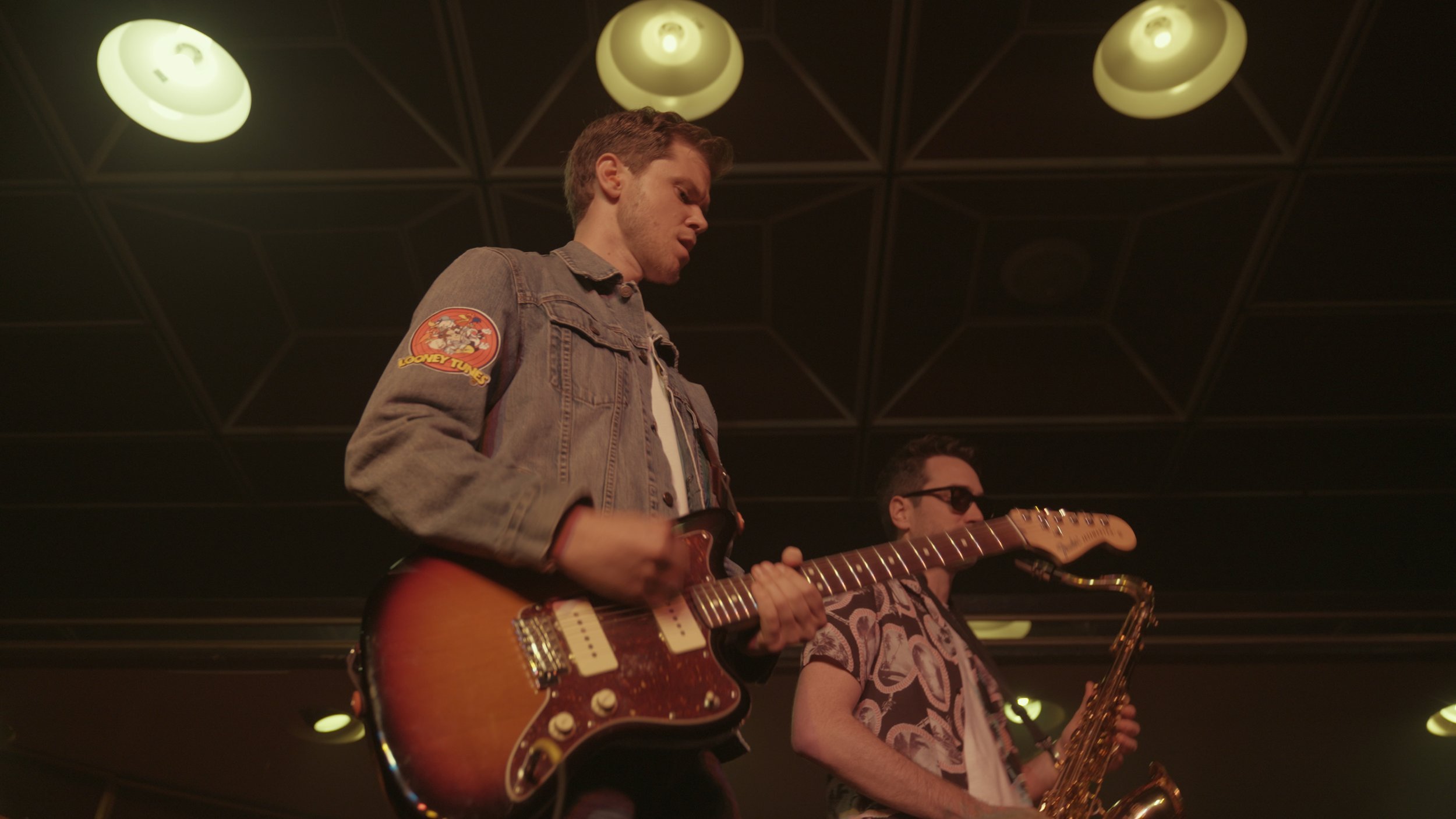KING TWEETY: CREATING THE SCORE
If you drive down the oil-slick street of Sunset Boulevard, all the way to the coast, you’ll find yourself at the ocean. Stop 5 miles before, however, and you’ll end up at the doorstep of SIR Instrument Rentals; a garish hive of energy, bursting with crushed velvet and cigarette haze. If that’s not Looney Toons, I don’t know what is.
That’s not where the story of King Tweety started. That’s where it ended. More on that later.
In November 2020, I got an email from Careen Ingle, director of some of the funniest Unikitty! episodes I had the pleasure to score. She was directing a new Tweety and Sylvester movie for Warner Brothers Animation, and wanted me to score it. Animation was one of the only types of film production that marched on during the pandemic, so the movie was ramping up to a feverish schedule in the following months. Over the next conversations about the story, we decided that this one was going to be different.
Musically, we treaded new ground from the series’ history. But still, we wanted to respect the annals of Looney history, which historically was “Mickey-Mouse” orchestra and blistering tempos. Given the times, an orchestra was, mostly, out of the question, so we landed on the next best option: 70s funk.
SUITES
My process starts with suites. Longform, winding pieces of music with many early ideas, orchestrations and soundscapes. Writing suites feels akin to writing words longhand. A self-imposed handicap to slow the artist down, and maybe discover something new in the process. Almost none of this ended up in the film.
However, for me, it’s the necessary first step. A step without the confinement of picture cuts, cats chasing yellow birds, or the pesky devil of self-doubt and deadlines. It changes the conversation from a technicalities of scoring into one about story. It doesn’t matter if it’s animation, there’s still plenty of musical problems to solve (many more than live action films, perhaps). Even if it’s a bird wearing a peanut costume getting walloped by another giant bird, that’s still a story. I don’t need much to start scoring. A small character sketch, a few backgrounds, visual pickings from the director’s subconscious are usually enough to get going. Careen and Austin Reinken (our endlessly talented Art Director) sent over initial designs of the movie’s villain: Diego Von SniffenStein. That’s the first suite I wrote on this film, over the course of three weeks.
A word about my process: I can write fast, but I want to write slow.
Under the pressure of deadlines and revisions, I can write out two minutes of music per day (more comfortably, one minute). Which I would consider ‘fast’. However, free from oppressive deadlines, I have the luxury of slow.
My musical suites contain all the orchestration details, which takes time. Days go by with a single note, others with two fully-orchestrated minutes. I like the slow because I can think about only the note in front of me and not 5 minutes down the stretch. Doubt is a pesky thing that pops up on the shoulder while writing, whether you write fast or slow. Slow quiets it a bit.
The Diego Suite took me the entire month of January 2021 to write. We were scheduled to start the scoring of the film in April, so I had a few months to write one more suite, aptly called “The Apartment Suite”. Very original. Oddly, I find naming my pieces of music one of the hardest parts.
The Apartment Suite, which you can hear here, was a much more straight-forward Looney Toons sound, infused with the 1970s retro flare. Only bits of this one ended up in the film.
The two suites set the blueprint for the actual scoring of King Tweety. The premise of the ‘score’ was to start out in a traditional Looney Toons style: a frenetic blast of “cat-and-mouse” music bopping along with Sylvester and Tweety. Slowly, we morphed into the new.
The actual work of creating the score took 4 months. The musical influences from the score and hard to pin because it’s truly all over the place. Saxophone. Orchestral “Mickey-Mouse” Scoring (Mickey-mousing is hitting individual moments, down to excruciating detail, and derives it’s name from old Mickey Cartoons). Brass fanfare with a synthesizer bass. All of the orchestra on this film is sampled, save for live bass, guitar, and saxophone.
In January, 2022, Careen and I sat in the dubbing stage to mix the film. At this stage, the music is done, and it’s now sitting in with the mixers letting them do their thing. I mostly stay quiet and feel lucky to listen to the movie in the best room possible and not a tiny soundbar. And five days later, the movie was finished. A note on finishing: it’s never easy, and always feels like letting something slip away just a few notes too early. I think that’s why I like the suites so much. You keep sculpting. Despite their nature, deadlines may be the key to everything, since it helps push you forward from something you might get stuck inside forever.
I end every project with a send-off. In this case, it felt right to go small, with a group of 5 musicians playing the end credits medley of the film. The music lends itself to a 1970s style funk band: a dusty Fender Bass, cheap guitars, Moog Model D (reissue!), a set of tubs, and a golden sax that twinkled in the showlights. So much of a film & TV scores lives within a few tiny studios; it’s feels good to let it out and have a breath of fresh air with sets of new ears.
Remember that showy, velvet studio I mentioned at the beginning? I googled for all of 5 minutes before finding SIR Instrumental Rentals. It was perfect. There was, however, one condition I asked SIR: “Do you have a smoke machine?”
They did. In fact, they had three. #1 was a dud, letting off only the tiniest of puffs. We sent it back and asked for another. #2 had another problem: it didn’t seem to have an off switch. It malfunctioned in the opposite manner, sending nauseating clouds of roiling vapor up into the room and out of the vents.
After our recording session, the SIR tech came up and asked how it all turned out. I told him everything was fantastic as I handed him back the now-empty smoke machine. “I know”, he said. “I’m sure it did. We’ve been watching fog coming outta the vents for an hour. Looked like a KISS concert in there”.
Not my intention, but that shoot turned into what must be the most rock and roll Looney Toons advertisement ever made. Someone check on that and send me an email if you find one with a saxophone.
A few acknowledgements and an introduction to our band, all of them fine musicians, artists and writers:
Ben Tuller on Bass
Nick Ainsworth on keys & saxophone
Arieh Berl AKA Pink Skies on drums
Careen Ingle on Tambourine and percussion
Special thanks to my co-writer Petro AP for helping me write “Everything Is Going My Way”. That song wouldn’t exist without those 4 little chords he brought into the studio the first day. And thanks to Pink Skies for adding guitar. Without him, there would be no funk.
Film scores aren’t created in a vacuum, although, it sometimes feels that way. There’s no other real way to do any creative work without putting one word or note or line in front of the other. There’s no soundtrack album for this film, but you can find our favorite cues posted on YouTube.
Finally: I’m grateful to Careen Ingle, and the production crew at Warner Brothers, for getting this little movie out the door so fast. So many other productions would shutter, push, or delay.
But this one kept on, fog and all.
-Nick
November 21st, 2022




